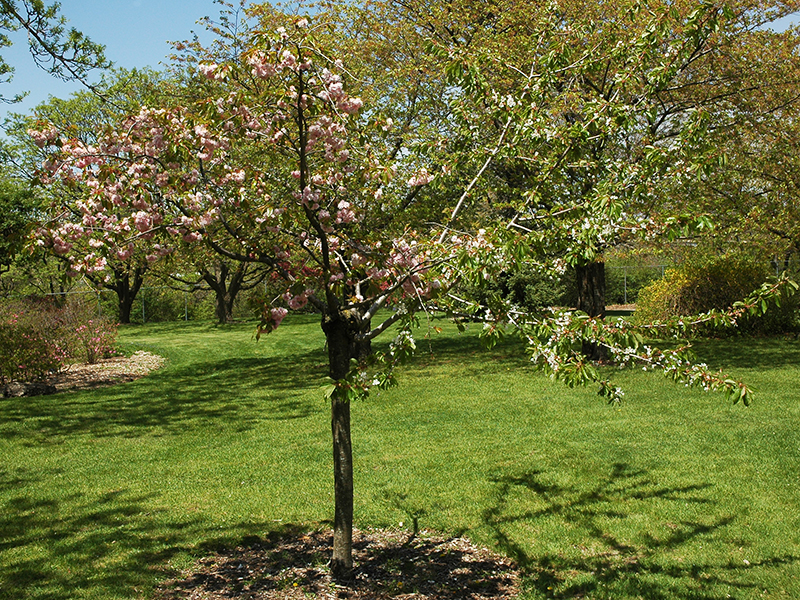
Woody > Prunus > Prunus serrulata > Prunus serrulata 'Kiku-Shidare'
Prunus serrulata
'Kiku-Shidare'
Cheal's Weeping Cherry
Origin: Developed in China, Korea and Japan.
Mike's
Opinion


"
This unique short-lived cherry tree is known for its weeping form that produces brilliant dense, attractive, double pink flowers with fifty or more petals. This magnificent tree can be used as a feature tree in a small garden and near ponds with its beautiful arched branches hanging over water. It will catch notice for its distinctive characteristics and will look incredible in many different landscapes.
Michael Pascoe, NDP., ODH., CLT., MSc. (Plant Conservation)
"
| Family |
| Rosaceae |
| Genus |
| Prunus |
| Species |
| serrulata |
| Cultivar |
| 'Kiku-Shidare' |
| Category |
| Woody |
| Type |
| Tree (deciduous) |
| Pronunciation |
| USDA Hardiness Zone |
| 5 - 8 |
| Canadian Hardiness Zone |
| 4a - 8a |
| RHS Hardiness Zone |
| H7 - H4 |
| Temperature (°C) |
| (-26) - (-7)C |
| Temperature (°F) |
| (-15) - 20F |
| Height |
| 4-5 m |
| Spread |
| 4 m |
Photographs
Description and Growing Information
Flowering Period
| General Description |
| A beautiful deciduous weeping cherry commonly used as an ornamental. It is identified by its stunning pink flower colour and weeping shape. |
| Landscape |
| This is a common ornamental tree, which can make a stunning specimen on lawns, provide limited shade for places such as patios. It is planted in small garden beds, used for borders and planted near water to create an incredible view. |
| Cultivation |
| It is grown in full sun to part shade in well-draining, acidic soils. Full sun tends to produce lovely flowering manifestation. |
| Shape |
| The young branches spread upward and as the tree matures, the branches become flatter and droop in a weeping form. |
| Growth |
| Medium |
| ID Characteristic |
| It is identified by its weeping form, large, stunning double pink flowers which are created in mid-late spring. This tree can also be identified for not producing fruit. |
| Pests |
| Diseases include powdery mildew, leaf spot, root rot, fine blight, and leaf curl. Pests include borers, leafhopper, caterpillars and Japanese beetles. Plum Pox: Symptoms may be confused with other diseases/disorders such as nutrient deficiencies or pesticide injuries. PPV symptoms can occur on leaves, flowers and/or fruit. Faint yellow rings or lines may be found on the leaves. PPV generally does not cause plant mortality however, can reduce the plant productivity and longevity. How to Reduce the Spread and Impact of PPV: 1. Propagate vulnerable Prunus trees and shrubs outside of the affected area a. Isolation is important to protect clean plants from future spread of the disease. b. Propagating and growing vulnerable plants away from the virus-infected area reduce the likelihood of the disease spreading any further. This should be as far away from the quarantined area and any potential sources of the virus. 2. Propagate Prunus plants with virus-free Budwood and Rootstock from virus tested mother trees a. This eliminates the propagation link for viral diseases. 3. Inspect vulnerable Prunus for symptoms a. All Prunus shrubs and trees should be visually inspected for symptoms at lease twice per year and conducted by trained personnel familiar with the virus. b. Any plants found to be infected should not be moved or sold and must be reported to the Canadian Food Inspection Agency immediately. c. Inspections should not be conducted in periods of hot weather (temperatures over 30˚C). 4. Manage aphid vectors a. Aphids are extremely attracted to suckers (vegetative shoots at the base of the tree), these should be removed to avoid aphid colonization, feeding or migration. 5. Plant tolerant and resistant varieties a. When available, grow plum pox tolerant or resistant Prunus varieties. |
| Habitat |
| Horticultural origin. |
| Bark/Stem Description |
| It has attractive red-brown smooth bark. |
| Flower/Leaf Bud Description |
| The buds of this tree appear pink and get paler as they emerge. |
| Leaf Description |
| Young leaves emerge bronze coloured and later turn glossy green in summer. These leaves can reach 7 cm in length. They are narrow alternating leaves with clearly defined margins. |
| Flower Description |
| This tree is known for its striking, large, double pink flowers with dense clusters, each with fifty or more petals. It produces attractive blooms, and flowers in April to May. The showy flowers are approximately 4 cm in diameter in the spring and have appealing yellow-orange autumn colour. |
| Fruit Description |
| All research has indicated that this tree does not produce fruit. |
| Colour Description |
| The leaves emerge bronze coloured and later turn a glossy dark green. The mahogany bark is a wonderful spring colour. The foliage is green and the bloom colour is pink. |
| Texture Description |
| Medium textured throughout the season. |
| Notable Specimens |
| Brooklyn Botanic Garden, Brooklyn, New York, United States of America. |
| Propagation |
| Propagation by split, grafting or softwood cuttings. Softwood cuttings include taking cuttings during the morning before mid-day heat. Remove the leaves except top one-third of stem and immediately put in plastic bag. Dip stem in rooting hormones, plant in container and keep between 70-75 °F until roots have developed. Roots should appear two to four weeks after process. |
References
Bailey, L. H. (1949). Manual of Cultivated Plants Most commonly grown in the continental United States and Canada, (Rev. ed.). New York: Macmillan Co..
Bryant, G., & Rodd, T. (2011). Trees and Shrubs: A Gardener's Encyclopedia. Richmond Hill,
Ontario.: Firefly Books.


